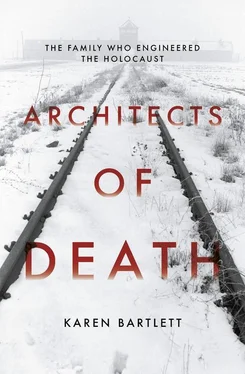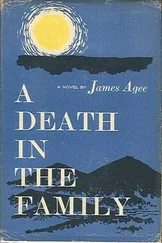Schultze’s factual and emotionless account can be read in conjunction with another account, given by special prisoner Henryk Tauber, who also witnessed the gassing. In May 1945, Tauber recounted the scene to a Polish Commission of Inquiry. ‘Once dusk had fallen, the first vehicles carrying people of various ages and sexes drove up. These included old men, women and several children. For about an hour these vehicles drove backwards and forwards between the crematorium and the railway station, bringing more and more people.’
Tauber and the other members of the special unit were locked in the doctors’ room at the back of the building, from where they could hear people ‘crying and screaming’. After two hours Tauber and his team were let out and ordered into the gas chamber.
In this chamber we found piles of standing naked bodies, all collapsed into each other. The bodies were reddish in colour, in places a very pronounced red, in other places they were covered with greenish marks. They had foam round their mouths, some of them had blood coming out of their noses, and most had soiled themselves. I remember that many had their eyes open; lots of the bodies were hunched up together and most of them were huddled together around the door.
Tauber explained that it was clear people had tried to get away from the columns through which the gas had been introduced.
We later realised that a lot of people in the gas chambers died of suffocation due to the lack of air, even before the gas had time to work. These bodies were the ones lying right on the bottom, right on the floor; the others had to run over them… Before the Zyklon was poured in, the air was sucked out – that’s what the ventilation in the chamber was for. [97] Schüle, op. cit., pp. 212–13. AS footnote 203: Record of the statement by Henryk Tauber, former prisoner in the Auschwitz concentration camp and member of the Sonderkommando [Special Unit – prisoners working in the gas chambers/crematoria], in: Piper, Vernichtung , p. 287f [see my note above.]
Once the special unit had removed the bodies, they started to load them onto iron gurneys ready for the Topf ovens:
Two prisoners put the bodies on them. They placed them so that the first body was lying on its back with its legs towards the oven and its face pointing upwards. A second body was put on top of the first, also on its back, but this time with its head towards the oven… Once the bodies were inside the cremation chamber; the sixth prisoner would hold them in place using an iron rod while the fourth prisoner would pull the gurney out from under them. [98] Ibid.
The prisoners would then have to open the doors to each cremation chamber so that an SS officer could check it had been loaded properly. This was the unvarnished truth of Topf and Sons’ technology in action.
Innovator that he was, Prüfer suggested a further improvement to the murder process: piping off some of the heat from the forced draught unit Topf had installed in the crematorium to warm the gas chambers, and speeding up the diffusion of the Zyklon B. Although this idea was seized upon by the SS, the heat from the continual use of the crematorium was so great that the forced draught unit did not work, and it was eventually dismantled. Neither Prüfer, nor Karl Schultze, who attended a meeting with the SS at Auschwitz to discuss the problem, were in any doubt about what ‘constant and without interruption’ use of the ovens meant. Schultze wrote: ‘While we were with Prüfer in the crematorium, the bodies of sixty dead prisoners were lying near the cremation oven; I assumed they had been killed in the gas chamber. Approximately twenty-five of these prisoner corpses were cremated in our presence.’ [99] Karl Schultze’s Soviet interrogation record, Landesarchiv Thüringen - Hauptstaatsarchiv Weimar.
Despite the competition within Topf and Sons to provide the SS with more efficient methods of murder, the building of the crematoria and the gas chambers were not progressing smoothly. In March 1943, fissures appeared in the eight-muffle oven in Crematorium IV after only two weeks. Ernst Wolfgang Topf replied to the SS that repairing this would only be under warranty ‘if the alleged damage was the result of faulty workmanship and not, for example, the oven being overheated, or metal tools being poked into the inner brickwork’. Although Topf found a temporary fix for the problem, it seemed that the cause of the problem was a design fault – the generator was too close to one of the muffles. This put the ovens of Crematorium IV permanently out of use, and meant the ovens of Crematorium V could only be used with cool-down periods every four to six weeks.
Two months later, the SS was communicating its dissatisfaction once again. Crematorium III was still not ready, Crematorium IV and V were faulty, and Crematorium II (the only fully functioning crematorium) had broken down due to a faulty chimney lining. On 20 May, Kurt Prüfer visited Auschwitz and was asked to find a solution to the chimney lining, which had been installed by a different company. Although he was accused by the SS of procrastinating, Prüfer eventually did this, but not in time to stop large parts of the lining collapsing into the flue.
In July, Prüfer contacted the SS with yet another complaint. Upset by the demands, Karl Bischoff, a member of the construction management unit at Auschwitz, demanded Topf and Sons repair the faulty lift in Crematorium II. Prüfer fumed in a letter: ‘This lift was not built by us, but was assembled and installed by your own staff. We are therefore unable to understand why you are trying to make us responsible for a system that was not supplied by us .’ [100] Schüle, op. cit., p. 219.
Prüfer appeared to have no fear in dealing with the SS, or negotiating his way out of an unfavourable deal when it suited him. The issue of the faulty chimney was finally resolved when the SS was reluctantly forced to agree that the problem had been caused by overheating (i.e. overuse). A file note referring to a meeting with the chimney builder and Kurt Prüfer at Auschwitz on 10 September 1943 states:
It has been brought to senior engineer Prüfer’s attention that [the chimney builder] has come up with a different excuse for the collapse of the chimney casing each time he has visited. At his last-but-one visit he claimed in the presence of the commandant that the collapse was due to the high stresses caused by the over-heating of individual ovens. [101] Schüle, op. cit., p. 219. AS footnote 230: ThHStAW, Collection Jean-Claude Pressac Nr. 42, sheet 452; also Buchenwald Memorial Archive, Pressac Collection, sheet 1117.
The chimney manufacturer, Robert Kohler; Topf and Sons; and the SS each agreed to each pay a third of the costs of the repair, with Ernst Wolfgang Topf concluding that the company was paying although ‘our acceptance of the above-mentioned sum in no way constitutes an acknowledgement of a legal claim to do so. We simply agree to the payment as a result of our current shortage of staff, which makes it impossible for us to enter into further correspondence on the matter.’ [102] Ibid.
This neatly worded compromise by Ernst Wolfang Topf raises another question in considering those responsible for Topf’s role in the Holocaust – the men and women who typed every letter, saw every order and recorded every phone call.
At the junior end of the scale was typist Annelise Hessler, who worked in the furnace construction division under Fritz Sander and Paul Erdmann. Hessler’s initials appear on many of Kurt Prüfer’s documents relating to his communication with the SS. A little higher up the pecking order were the technical draughtsmen who worked for Prüfer and Karl Schultze. Annegret Schüle names them as Hans Kohler, Walter Reinhardt and Sauerland from Department D, and Erich Krone and Horst Scharnweber from Department B (the ventilation department). Heading up the department were Fritz Sander and Paul Erdmann, who reviewed every order and often signed off on tricky correspondence. All of these people would have seen the design sketches, read the references to gas cellars, cremation capacities and corpse lifts. Overseeing all of Topf and Sons’ business was the main administration office, run by the manager of the commercial department, Max Machemehl, who oversaw the invoices that were sent to the SS, as well as chasing up any overdue payments (a significant task, as the SS were often very late in paying their bills).
Читать дальше












